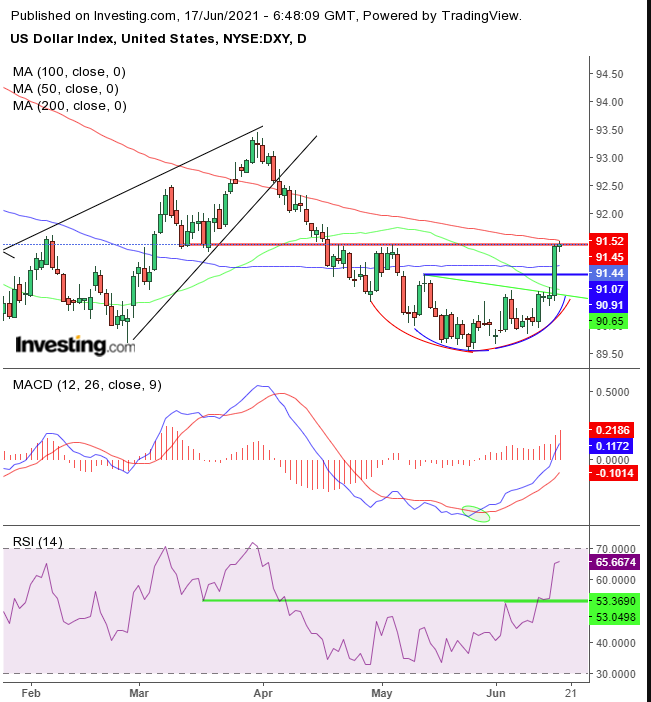If the words 'hawkish' and 'Fed' seem like an incongruous pairing, check out yesterday's FOMC statement. It appears the US central bank has had a change of heart after months of insisting inflation was "transient." The Federal Reserve now anticipates inflation to rise more quickly than policymakers projected just three months ago.
Underscoring that point, on Wednesday, the Fed announced it had moved up its expectation for raising rates, with the possibility of two hikes by the end of 2023. The US dollar gained 1% overnight on the news, its biggest jump since March 2020.
But the market has been front-running the Fed all along on inflation expectations, anticipating the possibility of tightening way before the FOMC statement. So why wasn't it already priced in? Likely because—when considering their previous policy statements—investors weren't prepared for the Fed's surprising move to get out ahead of inflation this quickly.
Aggressive traders looking to move ahead of the pack could take into account the fact that the Fed generally provides early warnings so as not to blindside markets. The central bank prefers to deliver bad news (aka tightening) in bite-sized amounts. As such, there's an argument to be made that the rate hikes will happen sooner than indicated and/or there could be more than two in the offing.
This view could be supported by the Fed's obliviousness thus far to already accelerating inflation. If they are slow to take action, one could argue, this pivot may already be too little too late. That is, inflation could be worse than the Fed realizes or lets on, and going forward they’ll have to act more aggressively to protect a recovery that follows an unprecedented economic shutdown.
Here's what that looks like for the USD from the perspective of supply and demand.

The greenback may have completed a rounding bottom, depending on one's interpretation. Given that the pattern has no straight lines, it’s challenging to determine a breakout.
Since the art of technical analysis seeks supply and demand strongholds on the chart, we'll look for additional clues to help recognize where buyers and sellers are hiding. Below, we provide three interpretations, suitable for three different levels of risk:
- The aggressive approach looks to the 50 DMA (green), which meets up with the shortest trend line (green). According to this view, an upside breakout shot clear of the (green) neckline. Momentum supports this price action, as the RSI found support after climbing past its previous, June 3 high—a failed mid-March support—and shot up further.
- A moderate trader may use the 100 DMA (blue), which appears to naturally mark a neckline, hovering above the May 13 high, arguably the first high within the rounding bottom. The price crossed that interpretive neckline, as well, though only mid-candle, as opposed to the more decisive aggressive penetration described above.
- The conservative read would be via the 200 DMA (red) which joins the highest possible part of the rounding bottom, confirming the late-April resistance, which flipped from the mid-March support. That neckline has yet to be breached. Indeed, today’s price action is flat, right on that resistance, allowing the possibility of a retreat. This could come as momentum may be decreasing as the RSI approaches 70.00, considered by most to be an overbought level.
Even if the price dips, however, it is likely to then return to retest the conservative neckline, as the slower yet steadier MACD gave a heads up to the bottom, when its short MA crossed above its long MA back in late-May.
Trading Strategies
Conservative traders should wait on a long position for the price to scale above the 200 DMA, create a full candle above that level and retest the 91.50 from above.
Moderate traders would enter if the price retests the 91.40 levels.
Aggressive traders could enter a contrarian trade, shorting the dollar on a likely dip, considering the sharp move that stopped dead at the 91.50 resistance of previous highs, lows and the 200 DMA, whose fundamental drive could be a possible Fed backtrack, to try and manage the market and avoid too much volatility.
Trade Sample – Contrarian, Aggressive Short Position
- Entry: 91.50
- Stop-Loss: 91.60
- Risk: 10 pips
- Target: 91.00 (moderate neckline)
- Reward: 50 pips
- Risk:Reward Ratio: 1:5
